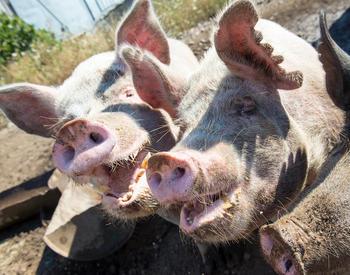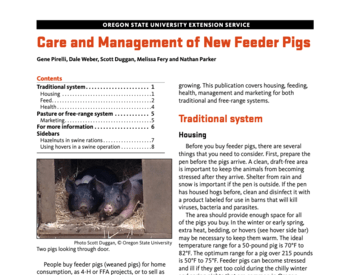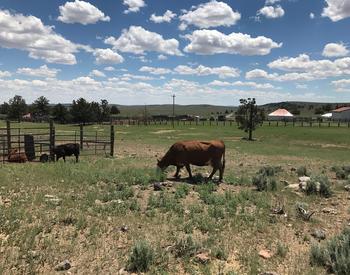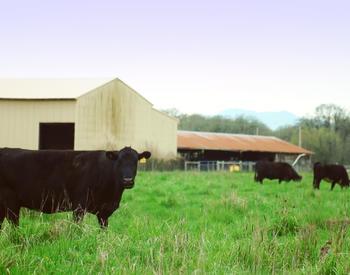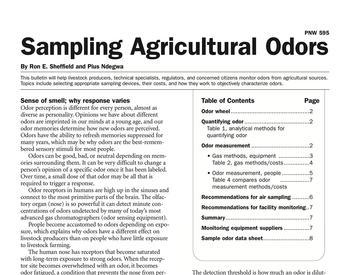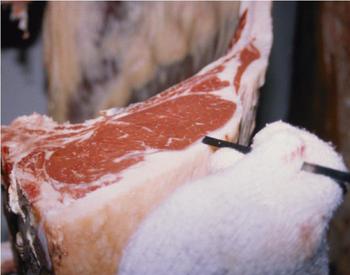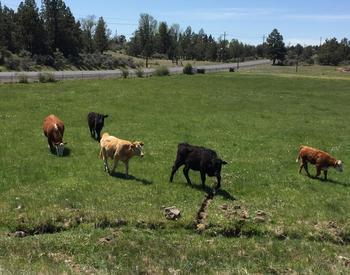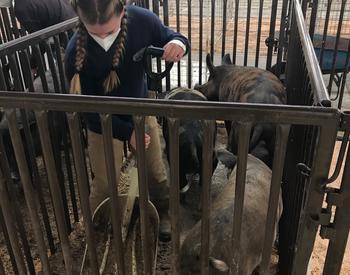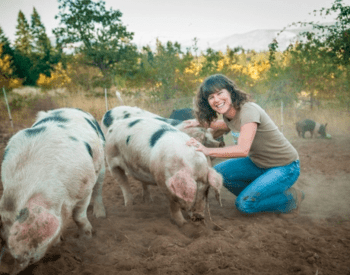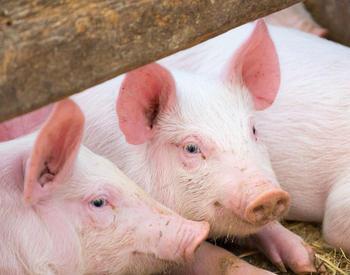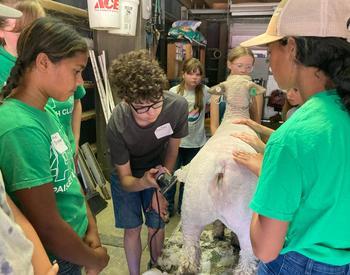This article contains suggested vaccinations and health practices for pork producers in Oregon regardless of whether it is a commercial herd, small part-time operation or a youth project. The old saying “an ounce of prevention is worth a pound of cure” really describes the value of a good swine health program.
Consultation with a veterinarian who is knowledgeable in swine diseases is helpful when developing a swine vaccination and health program.
Swine producers should vaccinate their pigs to prevent or decrease economic loss from important infectious diseases. Paying 25 to 50 cents per dose of a vaccine is much better than ending up with a $200 dead pig.
Microorganisms such as bacteria or viruses cause infectious diseases. When a pig is exposed to a microorganism, antibodies are produced. Antibodies are substances produced in the pig’s body as a reaction to invasion by that microorganism. Antibodies are specific to a disease and help to fight that disease.
These antibodies are part of the immune system in the pig. Immunity is the resistance to disease as a result of the production of antibodies by the immune system. Pigs usually have some antibodies naturally to resist disease. Many times the natural immunity is not high enough to prevent the disease and the animal becomes sick.
Vaccines contain "safe forms" of microorganisms that are injected into a pig to help its immune system resist disease antibodies. These safe microorganisms are either killed or modified-live depending upon the type of disease it will be used against. A vaccination with these safe organisms raises the immunity level by increasing the available antibodies and this helps to prevent the animal from getting sick. This is also called having a high resistance level to disease.
Second and third vaccinations for the same disease are called boosters. Boosters help to increase the immunity level even higher. Boosters are required for many vaccinations to be effective. Follow the vaccine label instructions as to when boosters are recommended.
Antibiotics, such as penicillin or tetracycline, are not vaccines. Vaccines are given to prevent a disease before it occurs. Antibiotics are given to treat a disease that has already occurred.
Pigs should be vaccinated for a disease before they will encounter the microorganisms causing it. It takes from 10 to 21 days after vaccination for the pig to develop a high resistance level. The exact length of time depends on the pig's age, the vaccine itself and whether the pig has been vaccinated before. The following chart (figure 1) will help to give you a basic and simple understanding of why animals become sick. As previously discussed, the resistance level is the amount of immunity in the pig.
Why animals get sick
Figure 1 shows that the resistance level is high because the animals have been vaccinated and have developed immunity to the organism. Along with this, the animals need to be in good overall health and not stressed from poor nutrition or poor housing.
The challenge level is the severity of the disease organisms that the pig may encounter. Animals stay healthy when their resistance level stays above the disease challenge level that they might encounter.
Figure 2 shows what happens when a disease outbreak occurs. The challenge level is increased above the animal’s ability to fight off or resist the disease. Examples of situations when animals will encounter a high disease challenge are:
- When purchased animals are brought home to your farm. Two things can happen. First, the new animals could introduce a disease organism that is not found on your farm and make your pigs sick. Or the new pigs that you purchased might not be resistant to organisms on your farm and get sick.
- When animals are exposed to other animals at a gathering site such as a sales barn or at any livestock show or display. Not all animals might be immune to the organisms passed around in the barn.
- When animals are observed to be sick and not separated from the rest of the population.
The best way to keep animals healthy is to raise their resistance level to disease. This is done by vaccination, good nutrition, parasite control and minimizing stress with good housing and care.
It is also helpful to lower the challenge level by isolating newly purchased animals or those brought home from the fair for at least three weeks. This isolation period is important because it prevents any opportunity for the new animals to pass disease-causing bacteria or viruses to the other pigs.
Since it takes time to build immunity after a vaccination, it is recommended that pigs be vaccinated a minimum of 21 days prior to taking them to a show, feedlot or any new location where there are other pigs.
Vaccinations are not a substitute for good pig management. If a pig's immune system is weakened by a stressful environment or inadequate nutrition, an overwhelming disease challenge can cause disease even in a vaccinated pig.
Store and handle vaccines according to label directions. Keep them refrigerated or cooled, as required, and out of sunlight. Improper storage can make a vaccine ineffective. Read the label to see what diseases and microorganisms the vaccine is designed to protect against. Make sure that you follow all slaughter withdrawal dates on the label.
Oregon vaccination recommendations
The following vaccinations are the ones most commonly used by swine producers in Oregon. Following these vaccination guidelines does not guarantee your pigs will be disease-free, however, it can reduce the risk of serious losses. Your veterinarian may suggest the deletion of certain vaccines or additional vaccinations to better match the disease risk to your pigs.
The vaccination recommendations below are listed as individual vaccinations, but combinations are available and used routinely in the swine industry.
All piglets (market, breeding and show)
| Age | Vaccination | Other |
|---|---|---|
| 1-3 days | Iron injection or oral iron. | |
| 7 days | Vaccinate for atrophic rhinitis, erysipelas and mycoplasma pneumonia if the sow has not been vaccinated. | |
| 4 weeks | Repeat vaccinations for atrophic rhinitis, erysipelas, and mycoplasma pneumonia, or vaccinate if not previously given. Also vaccinate at this time for actinobacillus pleuropneumoniae. | |
| 4-10 weeks | Deworm (This depends on weaning date, when weaning stress is over, and when combined with other pigs. Use a fecal test, if possible.) | |
| 10-12 weeks | Repeat actinobacillus pleuropneumoni. |
(Second deworming is optional depending on environmental conditions. Read withdrawal time required for dewormer used.)
Additional vaccinations for gilts, sows and show pigs
Gilts
| Age | Vaccination | Other |
|---|---|---|
| 6 months to pre-breeding | Leptospirosis, parvovirus, and atrophic rhinitis | Dewormer |
Repeat vaccinations according to label.
Sows
| Stage | Vaccination | Other |
|---|---|---|
| 4-6 weeks prior to farrowing | Atrophic rhinitis and erysipelas. Optional vaccinations are mycoplasmal pneumonia, transmissible gastroenteritis (TGE), and E. coli. | Dewormer |
| Prior to weaning or at weaning of litter | Leptospirosis, parvovirus, and erysipelas |
Show or project pigs
| When | Vaccination | Other |
|---|---|---|
| At purchase | Ask the seller what vaccinations have been given. The recommended vaccinations should be the same as in the first section for piglet to market. | |
| Two weeks after purchase | Dewormer | |
| Thirty days before show | Erysipelas |
Injecting vaccines
It is also important to use correct injection techniques. In order to be effective the vaccine must be administered properly. Use the proper needle size for the age of the pig and the type of injection. When using small gauge needles, make sure the animal is properly restrained to avoid breaking the needle. Polyhub (plastic at the base of the needle) needles are more likely to break if the animal is not properly restrained when giving an injection.
Avoid injections into the ham. Damage to the ham can result in condemnation of the cut at processing time. The Pork Quality Assurance Program recommends intramuscular injections be given in a spot on the neck just behind and below the ear. Subcutaneous injections should be given into the loose flaps of skin in the flank or elbow.
The following needle sizes and lengths are recommended by the Pork Quality Assurance Program:
Intramuscular injections
| Production stage | Gauge | Length |
|---|---|---|
| Baby pigs | 20 or 22 | 5/8" or 1/2" |
| Nursery | 18 or 20 | 3/4" or 5/8" |
| Finisher | 18 | 1" |
| Breeding stock | 16 or 18 | 1" or 1.5" |
Subcutaneous injections
| Production stage | Gauge | Length |
|---|---|---|
| Nursery | 18 or 20 | 1/2" |
| Finisher | 18 | 3/4" |
| Breeding stock | 16 or 18 | 1" |
Summary
This publication provides some of the basics of immunity and vaccination in swine along with the types of vaccines that are commonly used by Oregon pork producers. It is recommended that you consult a veterinarian who is knowledgeable in swine diseases when developing a vaccination program for your swine herd. Remember that along with vaccinations, good management is vital in preventing a disease outbreak. Finally, a sound vaccination program does not cost; it pays!
